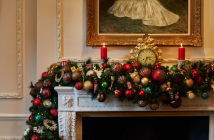It’s early afternoon by the time we pull up the immense, sweeping driveway at Hartwell House. And despite being so close to London – we could have made the Hoxton to Hartwell journey in less than two hours, if not for being drawn briefly off-path by the Chiltern Brewery’s 15th century taproom – it feels like another world.
Hartwell House is the only Southern outpost of the National Trust’s Historic House Hotels – the others being Middlethorpe Hall just outside York, and Bodysgallen Hall in the North Welsh wilds. Arriving at the main entrance, it’s as imposing in scale and grandeur as you’d expect from an estate that in its thousand years has played home to Prince John, and, during the French Revolution, to King Louis XVIII, who held court at Hartwell for his years of exile.
A liveried porter ushers us into the Great Hall, and then onwards to our room. We’ve been given one of the Royal Four-Posters, reached via a wide staircase bristling with Jacobean carvings – gargoyles, gorgons, classical gods, soldiers dangling maces. I’ve already nearly decided this staircase is the best thing in the whole of Hartwell House – reckless, considering I’ve yet to see our room, the spa, the haunted library or the famous, Capability Brown-era grounds – when our guide compounds that by telling us that there are two rogue, more recent carvings hidden among the antiques. Some of the statuary was damaged during Hartwell’s stint as a military garrison during the Second World War; the replacements chosen were Winston Churchill and GK Chesterton. When we find Churchill’s grumpy face and Chesterton’s suspicious one wedged among the gorgons and the gods, I revise that previous reckoning to put this staircase as the best thing in the whole of Buckinghamshire.
Obviously it was foolhardy to do that before seeing our room, which is impressive on a vast scale. It has towering ceilings, silk and brocade hangings, a whole wall of windows and windowseats, overlooking a lake and woodlands stretching to the horizon. The four-poster bed is of a size more commonly measured in acreage than feet. My handsome sidekick and I both live in flats in London that this room could probably swallow whole. I regretfully consign Churchill and Chesterton to the category of Not the Main Event.
We separate long enough for me to keep a massage booking, and for Ric to recon the Grecian poolhouse. And then we reunite an hour later in the outdoor hot tub in time to watch the sun set across the still-winter of the grounds, and occasional bursts of starlings taking off from bare trees. It’s stupidly, stupidly romantic at Hartwell House. Did I mention that? We walk back to the main house in gathering dusk, skirting a Gothic chapel and profusions of snowdrops. We lounge in the window seats, eating the welcome gift of homemade shortbread and dark grapes. We swan around in monogrammed dressing gowns, paying each other extravagant, baroque compliments that would be as likely to turn stomachs as they would be to warm hearts if they were repeated here.
And then we dress for dinner, trying to get used to the idea of being in polite society again. You can’t bombard people with this much romance and expect them to be good company for anybody but each other. Fortunately, Hartwell is of an enormity that lets you acclimatise slowly to the existence of other people. As we descend to dinner it’s two flights of stairs and several palatial corridors before we see anybody else, and this is on a weekend when the hotel’s fully booked.
We continue our slow resocialisation with cocktails in the Drawing Room – a Negroni and a Manhattan, because it feels right to stick with the classics when you’re in a room with ceilings this high, and fireplaces this Rococo. The public rooms are reported to be haunted, but there’s no ghostly activity in evidence this evening, although a plate of canapés and the dinner menus do turn up with almost-paranormal smoothness. We flip through the menus by the fire, and are very formally invited to place our orders from the comfort of the sofa before being summoned to the Dining Room.
It’s hard to say if we have that unhurried, members’ club ambience to thank for how well we’ve ordered, or if it’s just chef Daniel Richardson’s way with a menu. Whatever the reason, the Continental slant on local ingredients is in slick balance on both the braised rabbit ravioli and the Welsh rarebit and onion soup. There’s more edge to some of the dishes than you might expect from the stateliness of the surroundings – as with the red wine and liquorice reduction served with pan-fried sea bass, or Tonka bean ice cream on baked hazelnut and cherry tart – though my Oxfordshire beef bourguignon testifies it’s possible to go full-pelt traditional.
We linger a while over coffee and petits fours in the Drawing Room. Possibly in hopes of some supernatural sightings, possibly to draw out the evening – and this stay at Hartwell – as long as possible.
That’s partly why, leaving the next morning, we detour to Oxford on the way home: the day is young, and going straight from open parkland to the London public transport network without a pitstop in between seems like a terrible idea. There has to be a less brutal way to ease back into things.
Besides, after the lack of demonic activity in the haunted library at Hartwell, the Ashmolean’s Blake exhibition seems a more reliable source of preternatural horror. And Blake doesn’t disappoint: the focus is on the evolution of his craft – the apprenticeship process, the technicalities of intaglio and relief work – but the show’s no less consistently horrifying for that, and the hour we spend there is one packed with writhing otherworldly figures and biblical torments. We follow it up with the equally sinister Ed Paschke exhibition, a lurid, subverted Pop Art perspective on 20th century Chicago, from the Ashmolean’s post-war art series.
While wandering around the Ashmolean, at no point do I demand to know who all these other people are, and why they’re allowed to stand so close to me. I take that as proof that we’re ready for London, and that the dreamlike seclusion of Hartwell hasn’t ruined us for city living forever.
Just to test this, we find time for a drink in some of Oxford’s most historic, crowded, lowest-ceilinged pubs on the way out of town. Where we prove with some defiant public affection that really, exposure to the unshakeable romance of Hartwell House should come with a mandatory quarantine period afterwards. For the good of the citizenry.
For more information about staying at Hartwell House, an Historic House Hotels property and part of the National Trust, visit www.hartwell-house.com.
The Ed Paschke: Visionary from Chicago, 1968–2004 exhibition is on at the Ashmolean until 5th July 2015.




